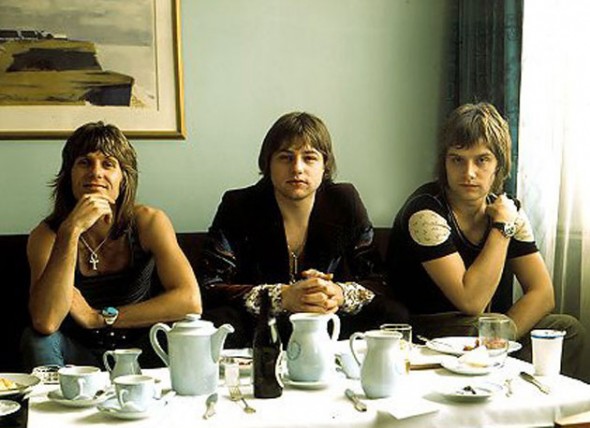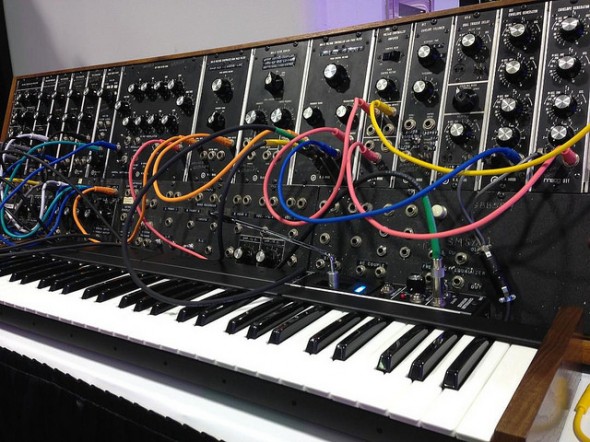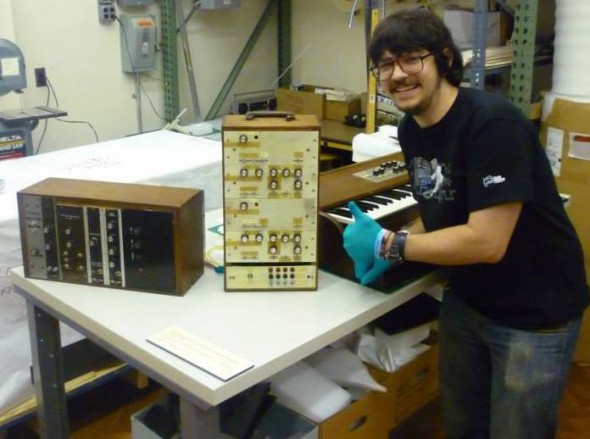Something new! A guest post from our new BMF student guestblogger Christian “Bubba” Ayoub, a recording engineer, synth geek and Maker from the Detroit area of the northeastern U.S.
Bubba began playing synthesizers at age 10 because of a love for progressive rock. He is currently seeking a dual degree in electrical engineering and software engineering, with plans to professionally design and build synthesizers.
We hope you enjoy his first guest post for the Bob Moog Foundation, an enthusiastic love letter to good synth design and great synth sound. We certainly did!
***
Recently someone started a conversation with me about synthesizers. Seeing as synthesizers are probably my favorite thing to talk about, this was a greatly welcome conversation. As things progressed, my conversational partner dropped a question of great significance (whether it is great or awful is really a matter of perspective and whether you’re okay with my long-winded hyperbolic ramblings):
“What is unique about Moog?”
Ladies and gentlemen, I HAVE BEEN PREPARING FOR THIS MOMENT MY ENTIRE MUSICAL LIFE. What follows is a slightly expanded version of my response.
1. When people talk about Moog, there’s an extremely good chance that they are talking about one of two synths: The Minimoog and the Modular Moog. Each has something different that’s special about them, and some things in common.
The key distinction is that the Minimoog is a single-keyboard, fixed-architecture monosynth with three oscillators, two envelopes, and noise. The Modular uses modular architecture, and thus can be reconfigured any number of ways (theoretically infinitely) depending on what sounds/textures are desired.
Also, no modular system is “typical” or standard. Each one is slightly different in terms of what modules are in it. Modular synths are fascinating topological case studies that way. There are layers of mutability that permeate everything about the final instrument and sound, and you can very easily miss the greater beauties as a result of hyper-focusing on the layers.
Most of Moog’s synths were fixed architecture, however. Modular synths, while absolutely wonderful for sound design and creation, are difficult to move and take a considerable amount of time to set up, so they aren’t exactly the most practical live performance tools.
This does not stop me. Nor did it stop Tangerine Dream, or Emerson, Lake and Palmer…or a decent number of people actually.
2. The Modular came first and so I’ll start with what makes it cool.
First, it’s an exceptionally well-designed instrument all the way around. Every Moog module was the result of incredible care and thoughtful design.
The oscillators sound beautiful, even if they go out of tune fairly easily. The biggest contributors to the “Moog sound” in the modular are the oscillators, the filter, and the mixer.
The mixer is technically not the greatest design, but it sounds absolutely gorgeous, and the way that the sounds intermingle with one another is truly beautiful. Shout out to Suit & Tie Guy for showing me, through his Mixer module, how crucial the mixer is in the Modular Moog sound.
**WHAT FOLLOWS IS A HIGHLY UNSCIENTIFIC SERIES OF ANECDOTES ABOUT USING A CLONE OF THE MOOG MIXER. DOWN YOUR GRAINS OF SALT AS NEEDED RIGHT NOW**
So I went to do this gig at my university in a giant engineering building and brought my modular (of course) and intended on using this one patch within it for a sequenced bass part. I used two simple, classic Doepfer VCO’s into the Suit & Tie Guy .MIX Moog mixer clone–and holy crap on a cracker was it fat!
I knew it was fat from working on the patch at home, at live volumes, but it took on this whole new dimension. It felt like the bass sound became a combination of a flamethrower, Tesla Coil, and distorted Minimoog.
I figured, okay, maybe it was just that gig, it’ll be different next time. NOPE.
I did another gig with a similar patch (different filter I believe, at a minimum) and same thing. Once I got it up to a good volume, it laid waste to all other bass sounds in the vicinity.
3. The filter. Oh, the filter. The Moog lowpass filter is one of the most important pieces of musical electronics, ever. It is safe to say that most of the classic Moog sound is in the filter. It resonates beautifully, and when swept there is nothing else that even comes close.
There are some light distortions of the signal that color it really well, too. It’s hard to describe, but is easy to discern with an actual synth in front of you.
The ladder filter, as it’s called after the way its transistors are arranged, is the only part that was patented in the modular and other Moog instruments. It sounds incredibly fat and has a wonderful, distinctive character that my words do not do justice to.
Once I was playing around with my ARP Axxe, controlling it using a sequence from my Eurorack modular and feeding the audio into the Moog Minitaur bass synth with its internal oscillators turned all the way down. It was striking how much closer to a Moog it sounded.
One of the most interesting things to do with any Minimoog is to feed its output back into itself using the External Input. This creates an easily controlled feedback loop and overdrives the filter even more than the mixer does to begin with.
4. The Minimoog. For all intents and purposes, the Minimoog was the first practical portable synthesizer that musicians could perform with. EMS beat Moog to market with the VCS3, and ARP’s 2600 was announced/released at the same trade show, but the VCS3 is a completely modular synth and (unless you are Tim Blake or Pink Floyd or on occasion John Paul Jones), nearly impossible to play in tune. The 2600 just wasn’t marketed as well at the outset.
The Minimoog took the most essential components in a modular system, and wired them together in an elegant way. A Minimoog can make quite the array of sounds with a very limited set of routings for the different pieces of circuitry within it.
Musicians connected with the Minimoog because it was capable of creating wonderfully interesting sounds both live and in the studio, and it just made sense. The Minimoog’s front panel flows so perfectly that people who knew nothing about the inner routings could still create good sounds very easily.
David Van Koevering set up Moog’s dealer network by going around to nightclubs and showing musicians that the Minimoog was an indispensable, important part of any rig. It also had pitch bend and modulation wheels on the end of the keyboard, which were brand new means of expression for keyboardists.
Other instruments had tried to afford keyboardists different means of controlling sounds, but once again, the wheels just made sense.
Players like Jan Hammer found themselves able to go up against guitarists and vocalists in terms of expressiveness and control over the entirety of a note. And a Moog can cut through a mix, so keyboard players could really step into the spotlight with mind-bending solos that stood out against guitars and other instruments.
***
BMF student guestblogger Christian “Bubba” Ayoub is a former member of the Maker Corps of the Henry Ford Museum, where he designed teaching plans meant to bring innovation into the classroom using the collections of The Henry Ford Museum and Greenfield Village. He has presented ideas at Maker Faire Detroit and the May Tinker Hack Invent Saturday at the Henry Ford Museum, made artbots with the public at the June Tinker Hack Invent Saturday, and taught workshops to teachers looking to bring Making to their classrooms.
He began playing synthesizers at age 10 because of a love for progressive rock bands like Yes and ELP, and voraciously seeks new and interesting music to listen to. His Juggable Offense project is an ever-shifting mass of psychedelic space rock centered around modular synthesis, Moog equipment, and sonic exploration.
Bubba is currently seeking a dual degree in electrical engineering and software engineering (with hopes of a life spent designing and building synthesizers) at the University of Detroit Mercy. Follow him on Twitter at @JuggableOffense, and check him out on SoundCloud.





